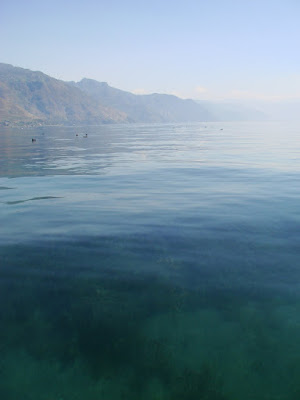Here's a Google Map to get you oriented. Volcán San Pedro is the farthest to the left, Tolimán is the northernmost of the paired cones and Atitlán is the southern one.
View Guatemala Volcanology in a larger map
We had time for visits to San Pedro La Laguna and a boat ride to Santiago Atitlán, and it was a great chance to do some relaxing sightseeing. I've seen some articles recently about the bad aspects of visiting Atitlan - they claim that the lake smells, is sludgy and brown, surrounded by robbers and banditos and all sorts of other nasty things. Well, I don't know what lake they were visiting, but I found very little of that to be the case. True, the lake is contaminated with bacteria from sewage and farm runoff, and I wouldn't recommend drinking the water, eating fish from it or going swimming, but there wasn't a bit of sludge in sight when I was there:
As for getting to the lake, there is one road (I'm not certain which) where bandits have pretty much made a business out of stopping vehicles and robbing people. It's fairly easy to avoid this road, however, and we had no problems despite being a bunch of gringos in a big shiny SUV. (No problems with people, anyway. The last bit of the road into San Pedro, which is basically switchbacks down the inside wall of the caldera, is crazy curvy, and not a bit of fun if there are buses on it with you. You can make the turns, but the buses can't, and it's impossible to see around the corners on the switchbacks. Drive really slow and honk a lot to let the bus drivers know you're there, because otherwise they'll run you off the road.)
In San Pedro, we stayed at the Hotel Mikasa, which is very nicely appointed (hot showers without exposed electrical wires!) and has a great European-Spanish restaurant on the roof (I definitely recommend the paella.) San Pedro is a bit of a hippie town - there are a lot of transplanted gringos and massage parlors (real ones) and solar-powered hot tubs - but it's pretty quiet, and has some interesting shops. And a great view first thing in the morning:
Santiago Atitlán has a much bigger population of the native Mayan groups, but it seems to be a major stop on the tourist route, because the main road is pretty much lined with shops and crawling with loud, clueless Americans. (It took me ten minutes of waiting to get a photo without a tour group in it!) The shops have some beautiful textiles, however, and there seem to be quite a few local artists who sell their work.
The boat ride was fun, although if there had been any more people in there I think the sides would have been about an inch above the water. Talk about a low rider! The boat service is fairly reliable, though, and only costs about five dollars for a two-way trip.
It was fun to go shopping there, but I'm sure we would have seen much more interesting things if we'd had more than an afternoon. Alas, we had to drive back to Guatemala City later that night, so we didn't have the opportunity for exploration. The views on the boat ride, however, totally made up for the short trip:
My recommendation is that Lago de Atitlán is definitely not to be missed. The smaller towns like San Pedro and Santiago Atitlán are difficult to get to but worth the trip, and the larger ones (like Panajachel) have a lot to offer as well. And they're all a boat ride away from each other!

















2 comments:
I thought Atitlan was one of the prettiest places I visited in Guatemala. Nothing like laying in the hammock, with tropical plants all around and a volcano on the opposite side of the lake. Thanks for your posts and bringing back memories
I love Lago De Atitlán for my children. My son Joe is love to go there. Lake Atitlán is commonly known as Lago de Atitlán. The lake is fashioned by bottomless escarpments which enclose it and by 3 volcanos that are placed on its southern border. Lake Atitlan is more set apart by towns as well as various villages of the Maya inhabitants.
Post a Comment